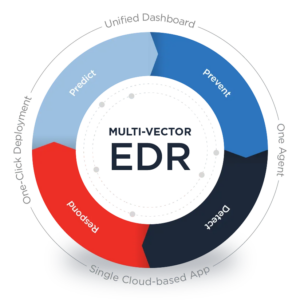EDR Cybersecurity solutions use raw telemetry data to generate alerts that help analysts discover, investigate and remove threats. EDR also provides contextual information based on related events to provide insight into how an intrusion occurred within their network.
An effective EDR solution integrates various layers of protection into one platform, such as signature analysis, sandboxing, and allowlist/blocklist matching. Key features of such solutions include:
Improved Detection and Response
Security solutions typically aim to stop threats before entering a network, impacting files, or damaging data. But prevention alone may not suffice – quick responses must also be in place when threats do manage to pass through – EDR provides that capability by alerting and empowering security teams to quickly detect threats, investigate incidents quickly and respond swiftly to contain and eliminate attacks that do manage to slip through and prevent future ones.
An EDR solution works similarly to a flight recorder, collecting endpoint telemetry to identify compromise and threat activity indicators, then comparing this against established baselines to detect anomalous behavior and suspicious activity. Once this information has been identified, it can prioritize, investigate, and respond quickly when threats appear – often within milliseconds! Some solutions also integrate with SIEM solutions to gain visibility across all layers of network environments while providing context and surfacing fewer high-priority alerts for further investigation.
EDR allows investigators to quickly identify the root cause of threats by showing which files it affected and exploiting vulnerabilities to enter, move around, or gain authentication credentials. Furthermore, it can show how an attacker moved between your networks, servers, or cloud systems. It can even provide attribution where applicable to help stop threats in their tracks – giving incident response teams greater clarity that traditional antimalware tools cannot.
Enhanced Forensics
When cyber breaches occur, cybersecurity professionals conduct forensic investigations with advanced tools to collect, acquire, analyze, and present evidence that helps understand an attack and bring hackers to justice. Their skills include an in-depth knowledge of computer operating systems, file systems, and cutting-edge digital forensic tools that allow investigators to restore social media data, search online searches, and investigate cell phone records while maintaining a chain of custody.
Other essential skills in the field of investigation include effective communication; investigators often need to translate technical information for non-technical stakeholders. Attention to detail is equally vital since even small pieces of data could prove pivotal in solving cases.
MSPs specializing in cyber forensics are well-equipped to help their clients halt threats in their tracks. From investigating hacking incidents or protecting data against further attacks to providing expert support for saving data and prosecuting criminals, these MSPs offer invaluable expertise in keeping clients secure.
Automated Remediation
Remediation (auto-remediation) enables cybersecurity tools to take proactive measures to mitigate threats and risks, including automatically closing vulnerabilities, disabling unneeded services, and enforcing patching schedules. Reducing threats’ impacts by locking down sensitive configurations, isolating or wiping systems, or restricting network connectivity can also help minimize their effect.
Automated remediation offers several advantages over manual solutions, primarily its faster response times. Even seconds can make the difference between minor issues and massive disasters, and waiting too long to respond can allow attackers to exfiltrate data, cause disruptions, and cause downtime across a business.
Automation also reduces toil for security teams, helping improve morale and satisfaction while freeing them up for more important work. Furthermore, automating fixes ensures issues can be dealt with quickly.
Many security solutions include built-in EDR functionality to prioritize, track and push remediation actions. NopSec’s platform offers one example that lets you prioritize misconfigurations within an environment and automate their resolution by sending notifications directly to your team members or initiating actions in your EDRR/Policy Management/Orchestration platform and then following up on their status.
Reduced Risk
EDR solutions monitor all activities at an endpoint to provide real-time visibility, threat detection, investigation, alert triage, and automated remediation capabilities. Advanced solutions also feature forensics capabilities which help operators track threats or discover a similar activity that would otherwise go undetected during an incident.
Continuing ION’s EDR solution can detect when previously considered safe files begin exhibiting ransomware activity, such as encrypting files or creating backdoors, providing organizations with an early warning and rapid response strategy to mitigate or prevent attacks.
If EDR software can determine that a file is malicious, it will immediately isolate the host into a sandbox environment to observe its behavior without risking larger network security. This allows EDR solutions to understand its nature more fully and any commands being run or actions undertaken.
EDR solutions provide organizations with continuous telemetry monitoring of their entire IT infrastructure, such as servers, databases, and hardware, to detect any abnormal behavior that may evade antivirus solutions and other preventive measures. Combined with SIEM (security information and event management) data, this provides improved threat visibility, speed investigations, and remediation. Finally, effective EDR cybersecurity solutions will offer visibility, protection, and response capabilities to withstand or minimize damages caused by cyber-attacks that bypass antivirus solutions or other preventive measures.
